Recent Water Damage Posts
Danger and Personal Risks Associated with Standing Water in Homes: What You Need to Know
1/18/2024 (Permalink)
Standing water in homes, whether caused by floods, leaks, or plumbing issues, can bring about significant risks to both the property and its occupants. Understanding and addressing these dangers promptly is crucial for ensuring everyone's safety. In this blog, we will explore the potential dangers and personal risks associated with standing water in homes.
Electrical Hazards
Standing water increases the risk of electrical hazards. Water can conduct electricity, leading to potential electrocution if it comes into contact with exposed wiring, outlets, or appliances. It is vital to cut off power to the affected area immediately and involve a qualified professional to ensure it is safe to restore power.
Structural Damage
Excessive water accumulation can weaken the structural integrity of a home. It can cause wood rot, the deterioration of drywall, and damage to foundations, leading to sagging floors, collapsing ceilings, or even structural failure. Prompt action, such as water extraction and proper drying techniques, is crucial to preventing long-term damage.
Mold and Bacterial Growth
Standing water creates a ripe environment for mold and bacterial growth. Mold can cause respiratory issues, allergies, and other health problems. Bacteria in the water may also lead to infections or illnesses. It is essential to address water removal and drying promptly to mitigate the risk of mold formation and bacterial contamination.
Slip and Fall Accidents
Standing water poses a slip and fall hazard, increasing the risk of injury for household members. Water can make surfaces slippery and decrease traction, increasing the likelihood of accidents. It is crucial to exercise caution, use appropriate safety measures like non-slip shoes, and promptly clean up and dry any standing water to prevent accidents.
Contaminated Water
In cases where standing water is a result of floods or sewer backups, the water may be contaminated with harmful substances, including sewage, chemicals, or debris. Contact with contaminated water can lead to various health issues, including infections, gastrointestinal problems, and skin irritations. Proper protective gear and professional assistance are necessary when dealing with contaminated water.
Potential Damage to Belongings
Besides the dangers to occupants, standing water can cause significant damage to personal belongings, including furniture, appliances, electronics, and sentimental items. Waterlogged possessions may become irreparable or require expensive restoration. Quick action, such as removing items from the water and contacting professionals for restoration, can help minimize damage.
Standing water in homes presents numerous dangers and personal risks, including electrical hazards, structural damage, mold growth, slip and fall accidents, contaminated water, and potential damage to belongings. Promptly addressing water issues, involving professionals when necessary, and prioritizing safety measures are critical in mitigating these risks and protecting both property and individuals.
The Ultimate Guide to Creating a Family Emergency Plan for Water-Related Incidents
10/3/2023 (Permalink)
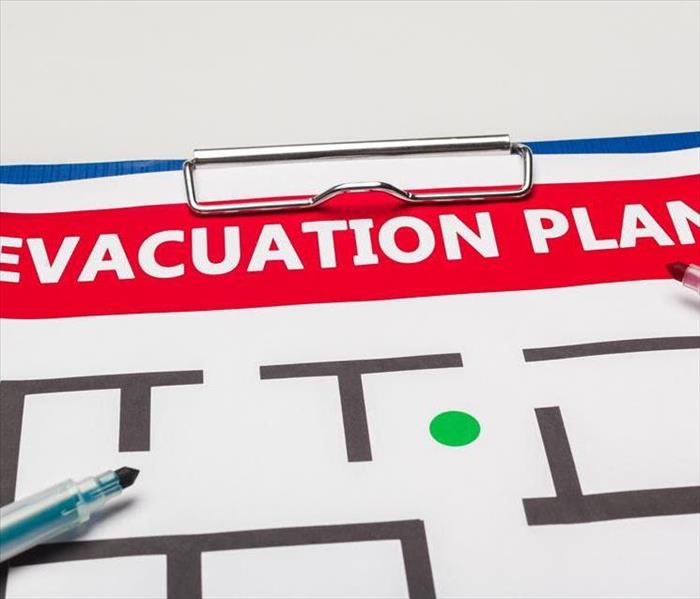 Creating a family emergency plan is crucial for the safety of your family.
Creating a family emergency plan is crucial for the safety of your family.
Water-related incidents such as flooding, burst pipes, or severe storms can be disruptive and potentially dangerous for your family. Having a well-prepared emergency plan in place can make all the difference in ensuring your family's safety and minimizing potential damage. In this blog post, we will guide you through the process of creating a family emergency plan specifically tailored to water-related incidents, enabling you to be proactive and prepared for any water-related emergency that may arise.
Identify Potential Risks
Begin by identifying potential water-related risks in your area. Research the history of floods, hurricanes, or other water emergencies in your region to assess the level of risk your family may face. Take note of any areas prone to flooding, potential issues with aging plumbing, or locations where burst pipes are more common.
Communication and Emergency Contacts
Establish a clear communication plan for your family. Designate an out-of-area emergency contact whom everyone can reach in case local communications are disrupted. Ensure that everyone knows how to reach this contact and has their phone number memorized or easily accessible. Additionally, exchange contact information with neighbors who can offer assistance in case of an emergency.
Develop an Evacuation Plan
If there is a risk of flooding or a severe water-related incident, it's essential to have an evacuation plan in place. Map out the safest evacuation routes from your home to higher ground or designated emergency shelters. Assign specific tasks to family members, such as packing emergency kits or gathering essential documents, to ensure a smooth evacuation process.
Prepare an Emergency Kit
Create a well-stocked emergency kit specifically tailored to water-related incidents. Include essential items such as bottled water, non-perishable food, first aid supplies, flashlights, batteries, a battery-powered radio, waterproof bags, extra clothing, and important documents. Ensure that everyone in the family knows the location of the emergency kit and how to use its contents.
Know How to Shut Off Utilities
Familiarize yourself with the locations of gas, water, and electricity shut-off valves in your home. Teach family members how to turn them off if necessary. In the case of a burst pipe or flooding, quickly shutting off utilities can help prevent further damage and ensure everyone's safety.
Water-related incidents can be dangerous, especially for children. Educate your family members on water safety measures and teach them how to swim if possible. Emphasize the importance of staying away from floodwaters, fast-moving water, or downed electrical wires during water emergencies.
Practice Drills and Review the Plan
Regularly conduct emergency drills with your family to ensure everyone remembers what to do in a water-related emergency. Practice evacuations, meet-up points, and utility shut-off procedures. Revisit and update your emergency plan as needed, especially if there are changes in your household or new information regarding the potential risks in your area.
Creating a family emergency plan for water-related incidents is crucial for the safety and well-being of your loved ones. By identifying potential risks, establishing communication protocols, developing an evacuation plan, preparing an emergency kit, knowing how to shut off utilities, educating family members on water safety, and practicing drills, you will be well-equipped to handle any water-related emergency that may occur. Remember, being prepared is the key to staying safe and minimizing the impact of such incidents on your family.
Understanding the Most Common Causes of Water Damage and How to Prevent Them
7/14/2023 (Permalink)
Water damage can wreak havoc on your property, leading to costly repairs and potential health hazards. Understanding the most common causes of water damage is crucial in order to take preventive measures and protect your home or business. In this blog, we will explore the primary culprits behind water damage incidents and provide you with valuable tips on how to prevent them. By being proactive, you can save yourself the stress, inconvenience, and expense of dealing with water damage.
Plumbing Issues
Plumbing problems are one of the leading causes of water damage. Burst pipes, leaking faucets, and faulty plumbing fixtures can result in significant water leakage. Regularly inspect your plumbing system for any signs of leaks, corrosion, or damage. Be sure to address minor issues promptly to prevent them from escalating into major water damage incidents.
Appliance Failures
Faulty or aging appliances such as washing machines, dishwashers, and water heaters can cause water damage if they malfunction or experience leaks. Inspect these appliances regularly, paying attention to hoses, connections, and seals. Replace any worn-out parts or damaged components to prevent potential leaks or water-related accidents.
Roof Leaks
A compromised roof can allow water to seep into your property, causing extensive damage. Inspect your roof regularly for missing shingles, damaged flashing, or cracked tiles. Address any issues promptly and consider professional roof maintenance to prevent leaks during heavy rains or storms.
Weather-Related Events
Natural disasters like hurricanes, storms, and heavy rainfall can result in severe water damage. Ensure your property is prepared by maintaining a functional drainage system, including gutters and downspouts. Regularly clean and clear these systems to allow proper water flow away from your property. Consider installing storm shutters or reinforcing windows to protect against strong winds and prevent water infiltration.
Basement Flooding
Basements are particularly vulnerable to water damage due to their below-ground level. Common causes of basement flooding include inadequate waterproofing, poor drainage, or foundation issues. Maintain proper grading around your home's foundation, install a sump pump, and consider waterproofing solutions to keep your basement dry and protected.
Water damage can have devastating effects on your property, but by understanding and addressing the most common causes, you can significantly reduce the risk. Regular inspections, timely repairs, and proactive maintenance are essential in preventing water damage incidents. Remember to consult with professional restoration experts, such as our SERVPRO of Oakville/Mehlville team, for any concerns or to mitigate water damage effectively. By taking preventive measures, you can safeguard your property, avoid costly repairs, and enjoy peace of mind knowing that you are prepared for potential water-related challenges.
Most Common Reasons Your Washing Machine Is Leaking Water
3/16/2023 (Permalink)
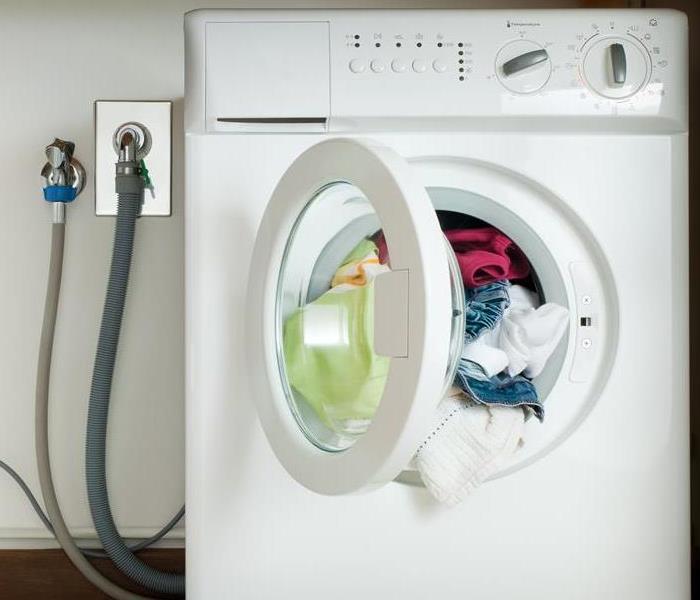 Noticing an usual sound with the washer could be a sign of malfunction.
Noticing an usual sound with the washer could be a sign of malfunction.
An improperly functioning washing machine can be a major inconvenience. If you're noticing an unusual amount of water leaking from your washing machine, it may be time to have it repaired by a technician. There are many reasons why this could happen, but fortunately, they're most often easily fixed by a qualified technician who can inspect your machine and make any necessary repairs. Here are some common causes of washing machine leaks:
The Hose Clamp Needs Tightening or Replacement
If you're experiencing a leak from your washing machine, the first thing to check is whether or not the hose clamp needs tightening or replacement. A hose clamp is a metal band that wraps around the hose to prevent it from leaking. If your washing machine hoses are loose and leaking water, tighten them with pliers before replacing them completely if they continue to leak after being tightened.
Tub Seal is Damaged
The tub seal is the rubber seal that separates the outer drum of your washing machine from its inner spin basket. This is one of the most common reasons for leaks in a washer, as it can become damaged over time or even break completely if you're not careful when loading laundry into your machine.
If your tub seal becomes damaged, water will leak from around the rim of your washing machine during spin cycles and can cause damage to walls and floors underneath it. Fortunately, this part is easy to replace.
Faulty Water Pump
The water pump is the motor that pumps water through the system, and it's usually located in the back of your machine. The most common type of water pump is a belt-driven motor that uses rubber belts to transfer power from its shaft to other components like pumps or motors within the unit. If any one of these parts fails, you'll start seeing leaks around where they're located--usually at joints or seams where two pieces meet up together. If you suspect damage from this cause and want help identifying what needs replacing before buying new parts, call us today!
A leak from the Drain Hose
If you notice water leaking from the washing machine, it could be coming from the drain hose. This is a tube that connects your washing machine to your home's drain pipe and carries away any excess water during use.
In some cases, damage or wear-and-tear can cause the hose to leak; in others, corrosion may have built up on its interior walls over time, this is especially common when using harsh detergents.
The Washing Machine is Unleveled
If your washing machine is leaking water and you've checked the hoses and pipes, it's likely that your laundry room floor is uneven. The most common cause of this issue is when a washing machine has been moved from one place to another, but it can also happen during installation.
Call A Professional For Assistance
If you're noticing an unusual amount of water leaking from your washing machine, it may be time to have it repaired by a technician. If your washing machine has been leaking water for an extended period of time, or if a sudden burst of water leaked out of your washing machine and damaged your laundry room, call SERVPRO Oakville/Mehlville for all your water damage cleanup and restoration needs!
What to do when your toilet overflows
2/5/2023 (Permalink)
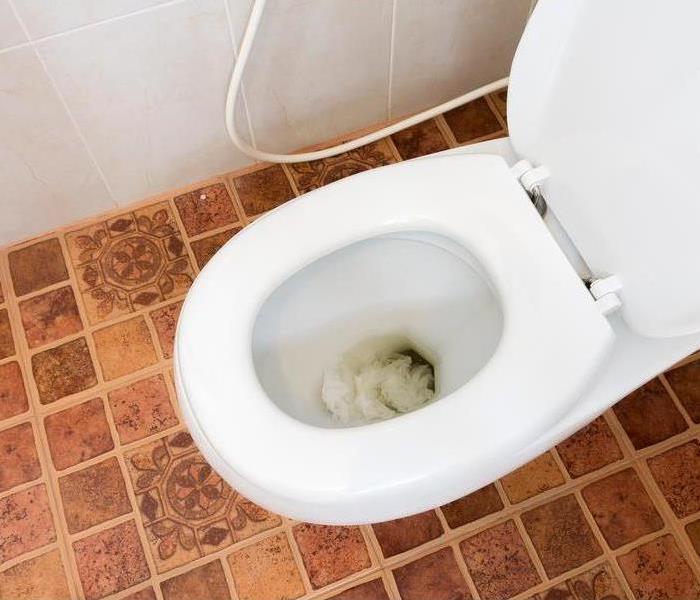 Toilets overflow causing serious issues and water damages
Toilets overflow causing serious issues and water damages
If your toilet overflows, it doesn't mean that you're going to have to buy a new one. There are ways to deal with this common plumbing problem, and they're easier than you might think.
Shut off the Water
At the first sign of water damage, shut off the water supply to the toilet. Turn off the main water valve that feeds your home, which can be found in your basement or crawl space. Shut off the water supply to the toilet at either its valve or tank, depending on which you find more convenient (if there's a valve for both).
If there's no way to shut off your toilet's water tank (or if turning it feels too dangerous), turn off a faucet nearby and fill up as many buckets as you need with clean water. Now use these for flushing purposes only. If possible, have someone do this so that both of you don't have to deal with any messes from overflowing toilets.
Turn off the feed valve to the overflow pipe
An overflow is one of the more common plumbing problems that you’re likely to encounter. While it may seem like a serious issue, you can usually handle a toilet overflow quickly and easily.
Once the water is turned off, next you want to turn off the water supply to the toilet. Turn off the feed valve to the overflow pipe and use a bucket or plunger to suck up all the water from the bowl, then empty it when you're done. This will help prevent water from overflowing into the floor causing more water damage.
Use towels on the floor to absorb water and prevent damage
If there is water puddles on the floor use old towels to absorb water and prevent damage. Use enough towels to soak up the excess water and protect your flooring. Don't leave the wet towels on the floor as it could cause more problems down the road. Keep the area free of debris to prevent slip and fall.
If you have a bathroom with tile floors, place the towels on top of each other, overlapping them slightly along their edges so that there are still gaps between them where water can drain through. Put them in a pattern around the overflow hole in your toilet bowl so that fluids that seep through can be caught by one of the layers of towels. This will help keep your floors dry even if there is still more water coming out of your pipes after you flush.
Bucket or plunger to suck up all the water from the bowl
Once the water is off the floor, use a bucket or plunger to suck up all the water from the bowl. This is probably your best option if you don't want to deal with a full toilet. Remove all the water from the bowl incase the toilet has to be replaced.
If your toilet has been overused or if there's been an increase in household traffic (such as company staying over), then try flushing less often until things return to normal. This will help prevent future overflows due to excessive use of your water supply system's capacity during peak times.
Use a Professional
If you're unsure about the problem, or if it seems like a more serious issue than your average clog, consider calling a plumber. A plumber can visit your home and assess the situation to determine whether it's something you can fix yourself (and what caused it in the first place). If so, they'll be able to teach you how to prevent future problems with your toilet.
When you are in need of a restoration company for your water damage, give SERVPRO of Oakville/Mehlville a call at the first sign of damage.
5 Steps To Prepare Your Business for the Next Winter Storm
12/1/2022 (Permalink)
 Create a plan for regularly checking and clearing out gutters.
Create a plan for regularly checking and clearing out gutters.
Follow These Five Steps
If you have a business in Bella Villa, MO, winterizing your commercial property for the colder months ahead should be a top priority once temperatures start to drop. Failing to properly protect your building can have high costs. A winter storm often brings heavy winds and snowfall that can do significant damage. To reduce the chances that you will need to hire disaster restoration professionals for the next spring thaw, follow these five steps.
1. Assess the Risks
Take a look around the property. Ask yourself: What kinds of risks could happen? For example, consider employee injuries and frozen pipes. Make any repairs that might be susceptible to structural stress or other types of storm damage.
2. Assign Responsibility
Another major part of preparing for a winter storm includes assigning roles and responsibilities to qualified staff and professionals. Figure out who is going to make the parking lot safe when it ices over. Additionally, if repairs are complex, decide which company you will call for assistance.
3. Plan for Each Threat
After identifying the wintertime risks your company might face, work with employees to create an action plan for each threat. If, for example, you have concerns about ice dams forming, create a plan for regularly checking and clearing out gutters.
4. Remember To Be Comprehensive
When you protect your building against storm damage, do not forget to be thorough. There are many potential locations for damage to occur. In addition to the roof, plumbing and HVAC systems should be other top concerns.
5. Prepare Your People
Preparing your property is important, but it is only half of the equation. The other half you have to remember includes the people who run the organization. Before the snow starts coming down, make sure you train everyone on any applicable procedures and have a way to communicate updates.
Running a business somewhere with harsh winters comes with unique challenges. Planning ahead can make things easier. You can help your company prepare for the next winter storm by following these steps.
What To Do If a Water Heater Leaks?
11/14/2022 (Permalink)
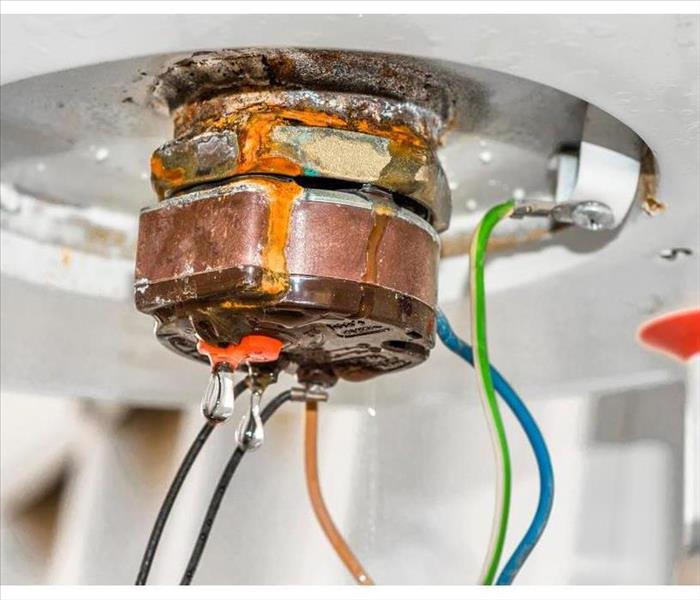 It's critical to understand what to do if your water heater leaks or malfunctions.
It's critical to understand what to do if your water heater leaks or malfunctions.
5 Steps to Take After your Water Heater Leaks
Water heaters are an essential part of your home. They heat water for showers and laundry, help keep you warm in the winter, and even provide hot water for cooking. However, just like any piece of equipment that runs 24/7, it's important to know what to do if your water heater leaks or breaks down. Here are some tips on how to handle a leaky or broken water heater.
First, shut off the water.
Shut off the water at the main valve. If you have a pressure tank, turn it to “off.” Or if there’s no pressure tank and your home has a well, go outside and shut off its valve as well. If you can't find your main valve or don't know how to turn it off, contact an expert; they will probably be able to help you locate it and guide you through this process safely.
Second, turn off the power to your water heater.
The next step in fixing a leaky water heater is to shut it down. This can be done by turning off the main power switch or circuit breaker, or by opening a cover plate over your water heater and flipping a lever on its electrical box so that you can't turn it back on again until you reset it. You'll also need to ensure that there's no gas running into your unit; if there is, turn off the supply valve for the gas line right away!
If there's no way of turning off both valves—either because they're inaccessible or because one is flooded—turning off power may be your only option for stopping leaks in progress.
Third, empty out your water heater.
The easiest way to drain water from a water heater is to open the drain valve on the bottom of the tank. If you don't see a valve, look for a small hole near the bottom. It should be labeled "drain."
To open the drain valve, use an adjustable wrench to turn it counterclockwise until it clicks into place. Then run your hand along the bottom of the tank to make sure there are no obstructions (like debris) in the way of allowing water to flow freely out of your tank.
The other option is to remove some of the water yourself using a bucket or container—but this isn't recommended unless you have a lot of experience with hot water heaters and know what you're doing.
Fourth, clean the area to prevent mold and mildew.
Once you've removed your items from the area, clean the area. This can help prevent mold growth and other unwanted things from developing if they were to encounter the water in your basement.
Fifth, repair your water heater or replace it.
If any part of your water heater has been damaged or if there is too much rust on it, it may be time for a replacement. If this is the case, contact a professional plumber who can perform repairs and/or install a new one in its place. Repairing or replacing your water heater will prevent that unit from causing any more damage.
We hope this article has helped you figure out what to do if your water heater is leaking and what the next steps are. If you have any questions, please feel free to contact us!
Steps for Basement Flood Remediation
8/15/2022 (Permalink)
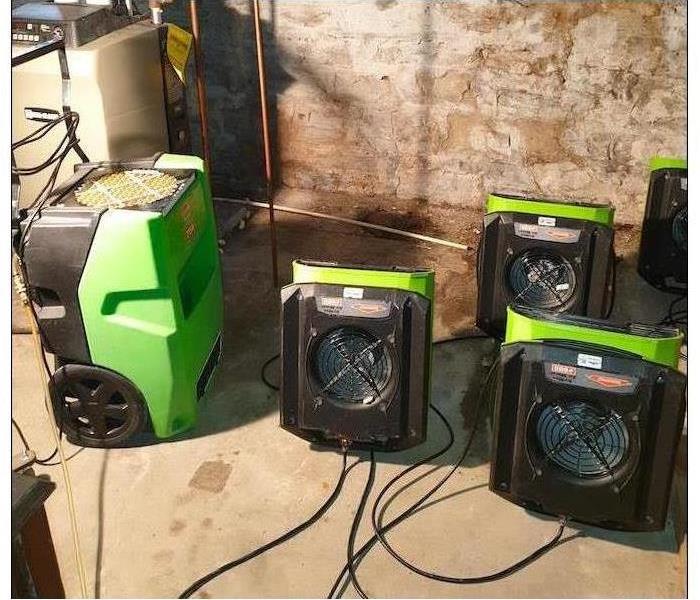 Flood restoration specialists have the equipment and expertise needed to fix a flooded basement.
Flood restoration specialists have the equipment and expertise needed to fix a flooded basement.
How to Clean Up a Basement Flood
There are several things that can cause a basement flood. A broken pipe, leaking appliance, sewer backup, or heavy storm can all result in standing water in the lowest level of your home in White House, MO. There are several steps you should take when you discover such a problem.
1. Call the Professionals
You should never wade into standing water on your own. Flood restoration specialists have the equipment and expertise needed to fix a flooded basement. Once you make the initial call, they can arrive within hours to handle every step of the process:
- Assessment
- Extraction
- Drying
- Cleaning
- Restoration
Take quick action to get the mitigation procedures started as soon as possible. A fast response can not only prevent secondary damage from the basement flood but also makes your home livable again in a shorter amount of time.
2. Review Your Insurance Policies
Your homeowner's insurance coverage may be able to save you a lot of the out-of-pocket expenses associated with flood remediation. Call your provider as soon as you can. The company will send an adjuster to survey the damage and come up with an estimate of how much your policy covers. Be sure to have the restoration company's detailed assessment on hand to support your claim.
3. Research Prevention
Once the flood damage in your home has been mitigated, it makes sense to look for ways to prevent future mishaps. Talk to the technicians about ways to keep water out of your basement, and invest in a reliable sump pump that can quickly get rid of any water that does enter. Ask neighbors with similar floor plans about the steps they have taken to make their basements more resistant to flooding. Your insurance agent may also be able to provide tips on upgrades you can make.
A basement flood can make a big mess, but quick remediation is the key to keeping it from getting out of hand. Act quickly to get the service and support you need.
What Types of Water Damage Are Covered By Your Homeowners Insurance?
7/28/2022 (Permalink)
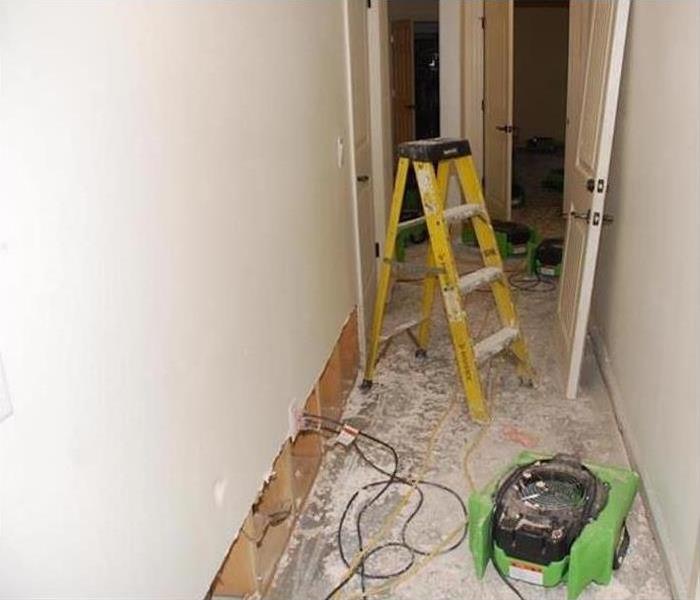 Water damage in a home in Mehlville, MO.
Water damage in a home in Mehlville, MO.
Which Water Damage Types Are Covered by Your Homeowners Insurance?
If a flood has occurred in your Mehlville, MO, home as the result of a broken pipe or appliance, then you will need to file an insurance claim to cover repairs. Because these can be costly, you may be wondering exactly what is included in your insurance policy. The following are a few types of damage that you might be dealing with.
1. Initial Damage
Initial damage occurs immediately after the pipe or appliance is broken, as soon as the water enters the home. This can include damage to a variety of items, such as electronics, furniture or paper items. This is almost always included in your insurance coverage, as long as the cause was not preventable.
2. Secondary Damage
Secondary damage that occurs due to the flood in your home is often included as well, as long as mitigation and repairs were performed in a reasonable time. This can include structural damage such as rotting or warped wood as well as the growth of mold and mildew.
3. Gradual Damage
If the pipe has not broken suddenly and instead caused damage through a persistent leak, then this is considered gradual damage and will likely not be included in your insurance policy. Because it is expected that the homeowner will perform proper maintenance, if you have noticed a leak and not bothered to have it repaired or you have not done regular inspections, then the insurance company may determine you are at fault.
4. Broken Pipes
Even if it was sudden and accidental, the insurance company will usually not cover the costs to fix broken pipes. This is generally seen as normal maintenance for the home, so you, as the homeowner, will more than likely be responsible for any necessary repairs or replacements.
To prevent the damage from getting worse, excessive water should be removed from your home immediately. A water damage remediation company can help fix the source of the flood, make repairs on your home, and salvage many of your belongings. Luckily, your insurance will likely cover most of the costs.
5 Ways To Prevent Your Pipes From Freezing
7/2/2022 (Permalink)
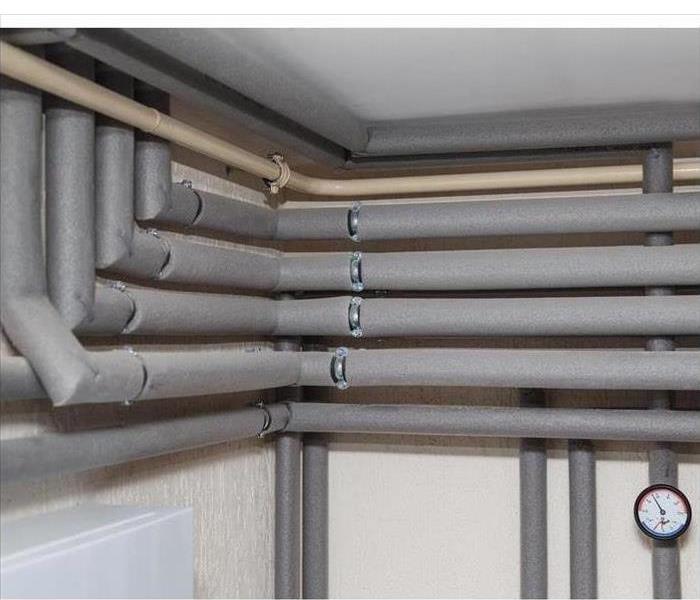 Any pipes located in colder areas of your house, such as the basement or attic, should get extra insulation.
Any pipes located in colder areas of your house, such as the basement or attic, should get extra insulation.
5 Ways To Avoid Your Pipes Freezing
Even if you live in a warm climate, you still have to worry about frozen pipes in your home. In fact, those who live closer to the Equator may be more vulnerable to this problem, as they may not have taken the steps necessary to protect their pipes.
If pipes get too cold, they can burst and cause severe flooding. While emergency restoration professionals can help you if a disaster occurs, you can avoid pipe freeze entirely by following the below suggestions.
Open Interior Doors
Pipes are often in cabinets that get cold in a hurry. Keep cabinet doors open so heat from the rest of the house can reach the pipes. Opening all of your interior doors can also boost the flow of heat throughout your home.
Apply Insulation
Any pipes located in colder areas of your house, such as the basement or attic, should get extra insulation. You can simply place fiberglass or foam rubber sleeves around pipes to keep them warm. You can add insulation to the ceilings or walls surrounding the pipes, as well.
Add Heating Tape
You can also use heating tape to prevent frozen pipes. This tape works best when placed on small sections of piping that you can easily monitor. Be sure to follow the instructions when using heat tape, as it can be dangerous if utilized improperly.
Keep the House Warm
Pipes are less likely to freeze in warm homes. Seal up any holes or cracks in your house that can let in cold air. You should also keep your heat on at all times, even when nobody is home.
Let the Faucet Drip
A frozen pipe bursts due to excess water pressure. You can relieve this pressure by slightly opening the faucet connected to the pipe in question.
Frozen pipes can have a disastrous effect on your Bella Villa, MO, home. Thankfully, you can avoid this issue by keeping your pipes sufficiently warm.





 24/7 Emergency Service
24/7 Emergency Service







